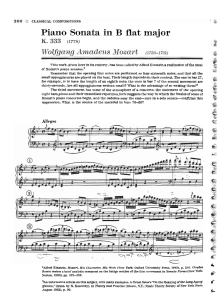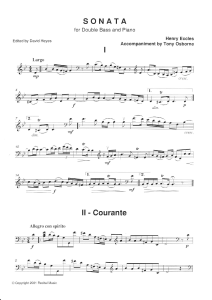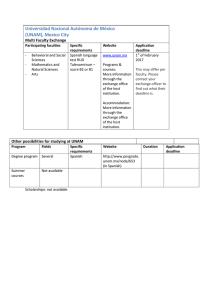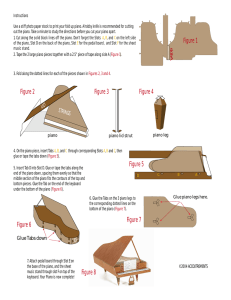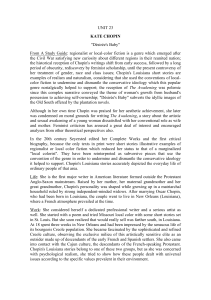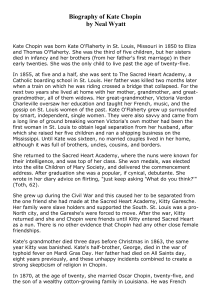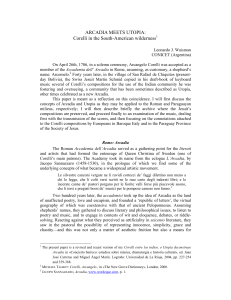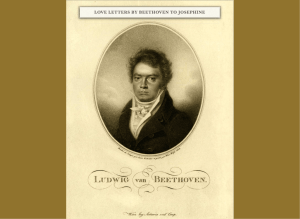recital de piano - Instituto de Física UNAM
Anuncio
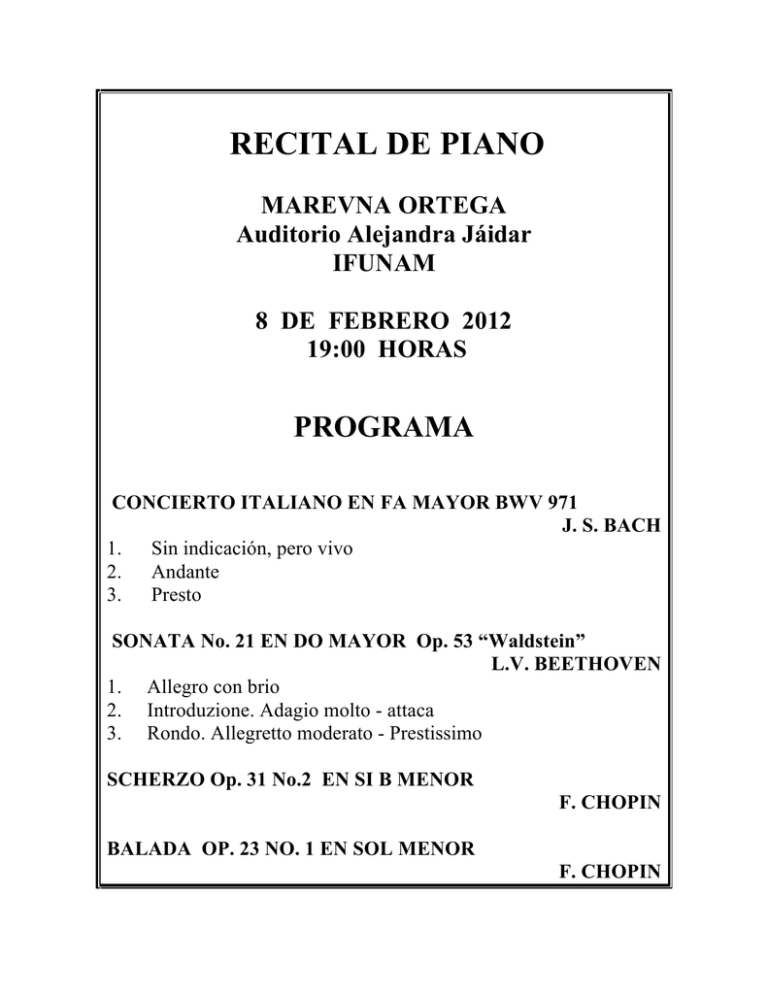
RECITAL DE PIANO MAREVNA ORTEGA Auditorio Alejandra Jáidar IFUNAM 8 DE FEBRERO 2012 19:00 HORAS PROGRAMA CONCIERTO ITALIANO EN FA MAYOR BWV 971 J. S. BACH 1. Sin indicación, pero vivo 2. Andante 3. Presto SONATA No. 21 EN DO MAYOR Op. 53 “Waldstein” L.V. BEETHOVEN 1. Allegro con brio 2. Introduzione. Adagio molto - attaca 3. Rondo. Allegretto moderato - Prestissimo SCHERZO Op. 31 No.2 EN SI B MENOR F. CHOPIN BALADA OP. 23 NO. 1 EN SOL MENOR F. CHOPIN MAREVNA ORTEGA ORTEGA Pianist Marevna nació en La Paz, Baja California Sur, México. Se inició en la música a los 8 años de edad, tomando clases de piano en la Casa de la Cultura de Aguascalientes. Posteriormente estudió bajo la tutela de la pianista rusa Aigul Kulova durante dos períodos cortos separados, cuando tenía 11 años y después a los 13, cuando se hizo merecedora de media beca en la Cheetham's School of Music, en Manchester, UK, que por falta de recursos no pudo disfrutar. En el 2009 se inscribió en la Licenciatura en Física de la Facultad de Ciencias de la UNAM y en 2010 realizó una estancia para desarrollar un proyecto en el Large Hadron Collider del Centre Europeen de la Recherche Nucleaire (CERN), cerca de Ginebra, Suiza. En 2011 concluyó esta licenciatura en Física obteniendo la Medalla Gabino Barreda por el mejor promedio de su generación. Recientemente recibió algunas clases maestras con el pianista Héctor Rojas y actualmente estudia perfeccionamiento pianístico con la pianista Ninowska Fernández-Britto, de la Escuela Nacional de Música de la UNAM. Ha dado diversos recitales en el país en los cuales se ha destacado por un impresionante virtuosismo, dominio de la técnica y su profunda interpretación musical. Marevna ataca cada obra de su repertorio en forma única y personal, lo que se transforma en una experiencia memorable para el público. Marevna was born in La Paz, Baja California Sur, México. She started her musical studies a the age of 8 taking piano lessons in the Casa de la Cultura de Aguascalientes. Then, she took lesson with the russian pianista Aigul Kulova Turing two separate periods, when she was 11 and 13 years old. At this time she was offered a grant to attend the Cheetham's School of Music, in Manchester, UK, which she could not accept due to financial problems. In 2009 se started Physics in the School of Sciences at UNAM, and in 2010 se joined a research Project at the LHC (CERN) in Switzerland. In 2011 she finished her undergraduate studies with honours obtaining the Medalla Gabino Barreda, which is a distinction given by UNAM for the highest notes of the generation. Recently, she took master classes with the pianist Héctor Rojas, and presently she is taking execution lessons with the pianist Ninowska Fernández-Britto, of the National School of Music, UNAM. She has given several piano recitals in Mexico that have been outstanding because of her virtuosity, command of the piano technique and her deep musical interpretation. Marevna plays every work in her repertoire in a unique and personal fashion, which translates in a memorable experience for the audience. PROGRAMME NOTES by Rafael A. Barrio, Investigador Titular C del Instituto de Física de la UNAM (taken from Wikipedia). ITALIAN CONCERTO IN F BWV 971 J. S. BACH The Italian Concerto, BWV 971, whose original title is: Concerto nach Italienischem Gusto (Concerto after the Italian taste) was published in 1735 and is a three-movement concerto for two-manual harpsichord solo. The Italian Concerto's two lively F major outer movements, in ritornello style, frame a florid arioso-style movement in D minor, the relative minor. An Italian concerto relies upon the contrasting roles of different groups of instruments in an ensemble; Bach imitates this effect by creating contrasts using the forte and piano manuals of a two-manual harpsichord throughout the piece. In fact, along with the French Overture and some of the Goldberg Variations, this is one of the few works by Bach, which specifically require a 2-manual harpsichord. However, Sometimes these works are played on the modern piano. For a period in the late 18th century, Joseph Haydn and Thomas Arne wrote concertos that could be played interchangeably on both harpsichord, fortepiano and (in some cases) pipe organ. The Italian Concerto has become popular among Bach's keyboard works, and has been widely recorded both on the harpsichord and the piano. SONATA No. 21 IN C Op. 53 “Waldstein” L.V. BEETHOVEN The Piano Sonata No. 21 in C major, Op. 53 is considered to be one of Beethoven's greatest piano sonatas, as well as one of the three particularly notable sonatas of his middle period (the other two being the Appassionata sonata, Op. 57, and Les Adieux, Op. 81a). The sonata was completed in the summer of 1804. The work has a scope that surpasses Beethoven's previous piano sonatas, and is notably one of his most technically challenging compositions. It is a key work early in his 'Heroic' decade (1803-1812) and set the stage for piano compositions in the grand manner both in Beethoven's later work and all future composers. The Waldstein receives its name from its dedicatee Count Ferdinand Ernst Gabriel von Waldstein of Vienna, a patron as well as a close personal friend of Beethoven's. This sonata bears Waldstein's name though there are other works dedicated to him. It is also known as 'L'Aurora' (The Dawn) in Italian, for the sonority of the opening chords of the third movement, which conjures an image of daybreak. SCHERZO Op. 31 No.2 IN B FLAT MINOR F. CHOPIN The Scherzo No. 2 was composed and published in 1837, and was dedicated to Countess Adèle Fürstenstein. Schumann compared this scherzo to a Byronic poem, “so overflowing with tenderness, boldness, love and contempt”. According to Wilhelm von Lenz, a pupil of Chopin, the composer said that the renowned sotto voce opening was a question and the second phrase the answer: “For Chopin it was never questioning enough, never soft enough, never vaulted (tombe) enough. It must be a charnel-house”. The melody, marked con anima, is repeated three times during the lengthy proceedings, the last time bringing us to the coda in a magnificent key change. The gorgeous melody overlies a six-note-permeasure left-hand accompaniment of exceeding richness. The trio, filled with longing, takes on a pianistic complexity. Huneker exults, “What masterly writing, and it lies in the very heart of the piano! A hundred generations may not improve on these pages”. BALLADE OP. 23 NO. 1 IN G MINOR F. CHOPIN The Ballade No. 1 was composed in 1835–36 during the composer's early years in Paris and was dedicated to Monsieur le Baron de Stockhausen, the Hanoverian ambassador to France, and reportedly inspired by Adam Mickiewicz's poem Konrad Wallenrod. Chopin seemed to have been fond of this ballade: In a letter to Heinrich Dorn, Robert Schumann commented that, “I received a new Ballade from Chopin. It seems to be a work closest to his genius (although not the most ingenious) and I told him that I like it best of all his compositions. After quite a lengthy silence he replied with emphasis, 'I am happy to hear this since I too like it most and hold it dearest.'” The piece begins with a brief introduction which, contrary to popular belief, is not unrelated to the rest of the piece. The main section of the Ballade is built from two main themes. The brief introduction fades into the first theme. After some elaboration, the second theme is introduced softly. This theme is also elaborated on. Both themes then return in different keys, and the first theme finally returns again in the same key, albeit with an altered left hand accompaniment. A thundering chord introduces the coda, marked Presto con fuoco, to which the initial Neapolitan harmony re-emerges in constant dynamic forward propulsion, which eventually ends the piece in a fiery double octave scale run down the keyboard. As a whole, the piece is structurally complex and not strictly confined to any particular form, but incorporates ideas from mainly the sonata and variation forms. Technically, many passages of the Ballade are exdeedingly demanding, requiring rapid scales, very fast and large chords, octaves, and difficult fingerings.
